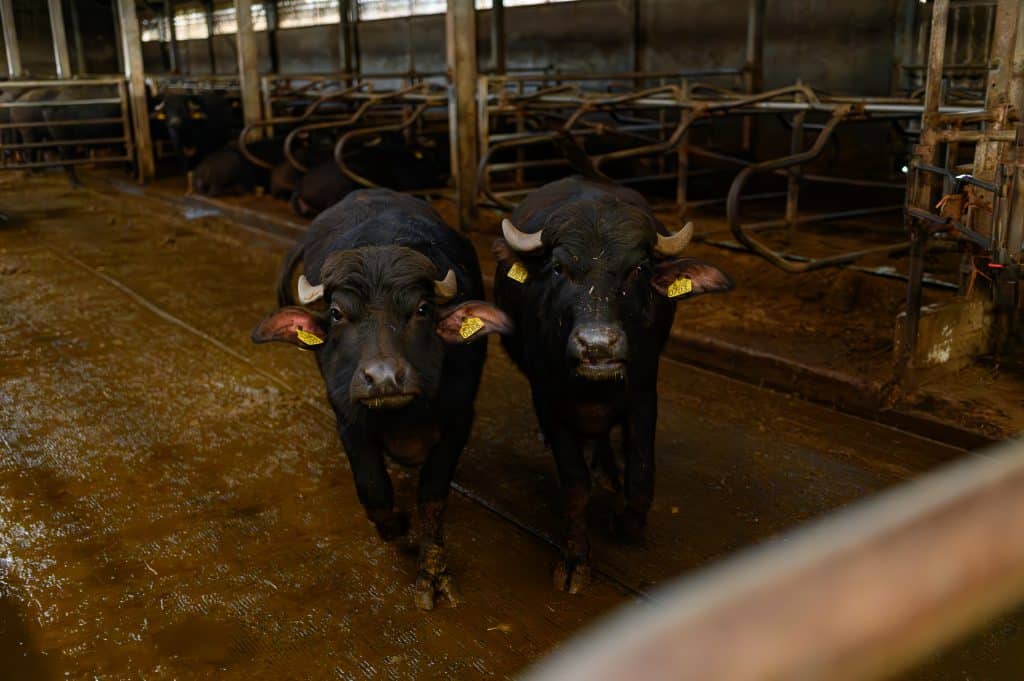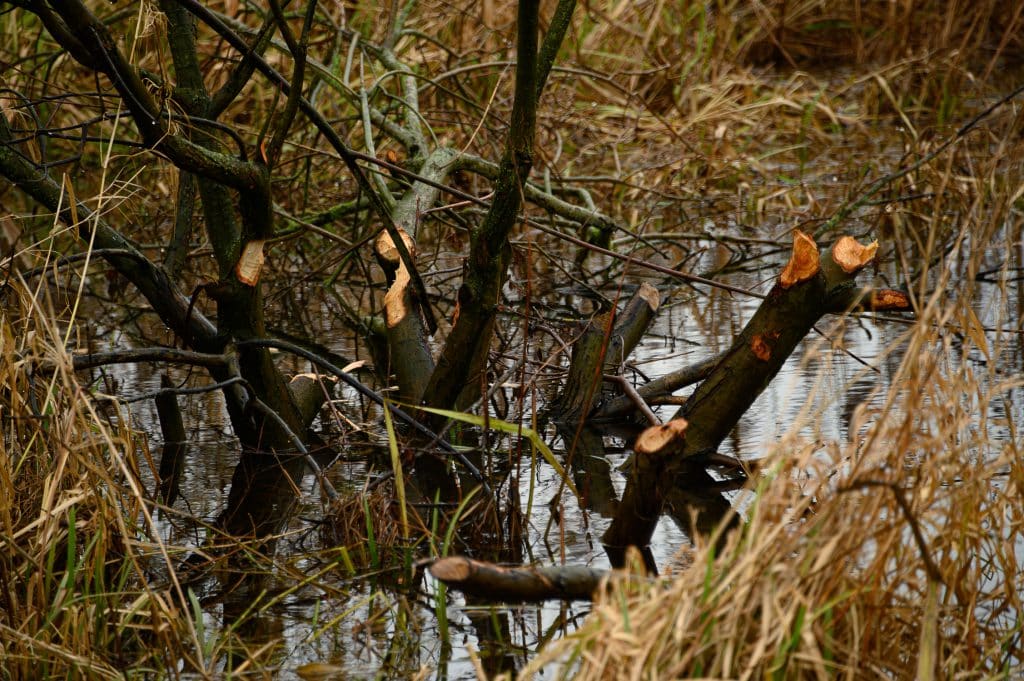Prisca Visser is a photographer with a love of the outdoors and nature. For the Biesboschlinie she regularly goes out to capture stories. She visits Buffelgaard Verschure and takes a historical walk through Het Wijkerzand.
Prisca Visser is a photographer with a love of the outdoors and nature. For the Biesboschlinie she regularly goes out to capture stories. She visits Buffelgaard Verschure and takes a historical walk through Het Wijkerzand.
Buffalo have a unique smell, very different from cows. Did you know they can grunt softly when they are curious? Today I am visiting Buffelgaard Verschure, a buffalo farm run by Richard and Monique. I'm on the early side. "The car still needs to be taken to the garage for a while though" says Monique after our greeting. "Just walk around the barn, feel free to take a look at the milking robot, right back!" Off she goes.




Somewhat embarrassed, I walk into the large barn. The smell of buffalo is really different from the cows I am used to. Something, spicier perhaps? The hefty animals stare at me from behind the fence. Soft grunts rise up: who is this woman and what is she coming to do? When I get a little closer, it gets crowded. They all want to sniff, and especially to be petted. Soon I notice that behind the tough exterior are very sweet and gentle animals. They have short legs and their bodies are broad and stocky. Originally they come from Asia, where they were widely used in agriculture to plow the fields. Buffalo have very dark fur, almost black even. With their large ears they can wave coolness to themselves on hot days. But most beautiful of all are the huge, curved horns!



Monique is soon back, together we walk around the stables. Why water buffalo? I'm curious about that. The answer to that is pretty simple. Richard grew up on a farm. After he met Monique, they embarked on an adventure together abroad. After Denmark and Germany, they returned to Altena, bringing two children with them. "Buffalo did not require phosphate rights, and we wanted to try something new" explains Monique. "It took a lot of getting used to for all of us in the beginning. For us, but also for the animals themselves." The many hours, love and patience, were rewarded. The buffalo are now so used to getting into the milking robot on their own, there is almost no need to look after them.
When I ask what exactly is in the boxes, Monique replies, "those are onion peels, from an onion processor nearby. We like to work locally and support each other that way," she adds. For them this is waste, our buffaloes are very happy with it again. In addition to local collaborations, we also strive for sustainability. Last year, solar panels were installed on the roof and the farm has its own groundwater well.

Water buffalo milk is much creamier than cow's milk. That's because the fat percentage is twice as high. Buffelgaard Verschure has various products made from their milk that are for sale in the little store and in the farm vending machines located outside in a shed. I see beautiful cheeses, a freezer full of meat, grill sausages and, of course, the buffalo mozzarella. But also specialty beer, chocolate and ice cream! All sourced from the buffalo.
We walk past the young cattle pens, where Monique enthusiastically talks about the young buffaloes and the oldest lady of 16. In summer it is an attraction to see the dark, horned heads in the pasture. Some are even allowed into the water, after which you only see ears and noses sticking out above the mud. They look like hippos! I will definitely visit when the time comes. Now I really have to say goodbye to these cute animals and hospitable family.



My next stop is The Wijkerzand, a vast area along the banks of the Afgedamde Maas. It's raining. Not by much! Thick drops clatter on my umbrella. It must have looked so different in the old days. And then again, it wasn't...
A girl appears before my mind's eye. She will be about twelve years old. Hard she runs through the fields to the waterfront. It is June in the year 1817 and oppressively hot. Sweat runs down her face in droplets, but she does not stop. Only when she reaches the water's edge does she bend over panting. Supporting herself with her hands on her knees, she looks out over the river. In her mind it storms, today is such an exciting day! Her whole existence and that of her family may well depend on the decision that will be made. At home she couldn't stand it any longer, she had to leave.
A barge drifts slowly by on the river, voices of the crew blaring across the water. Slowly Anne lowers herself into the tall grass. The blades of grass tickle her bare legs under her long skirts. Staring at the sky, she feels her thoughts settle down. Would Dad be angry? He went out the door so early this morning.



Her dad is shear master of Het Wijkerzand. Last year the county came up with the decision that the floodplain does not belong to the residents, but to the municipality! The two cows they kept here on the shearing pasture had to go. The money they got for this is already almost gone, and there is no fresh milk now either. Just now mom is heavily pregnant and they can put the milk and produce to good use with another mouth to feed. Fortunately, a lot of people disagree with this decision. The mayor had begged the county if they would reverse it. Then her dad and three other scissor rights holders sent a petition to the king himself. King William I informed them that he did not agree with the province and that the justice of the peace in Heusden should rule. That ruling came today, June 3, 1817.
There are rumblings in the distance. There must be thunder after such a hot day. A few cows have come closer. Curiously they look at the girl lying in their grassy meadow. Anne pushes herself up, shakes off her skirts and slowly trudges toward the small house behind the dike.

What Anne does not yet know is that the justice of the peace vindicates the natives of Wijk. To this day, the so-called "natives" of the church village of Wijk own Het Wijkerzand. Provided you were born within its boundaries (so not in the hospital, that doesn't count) and have your own chimney smoking there. The remarkable thing is that this also applies to women. If Anne moves out in adulthood, but continues to live within Wijk, she automatically becomes a co-owner. That means she gets annual income from it and even gets to graze her own cow in the Scissors Meadow.
Together with Ad and Fientje, I move into the area. Ad de Bruin is a "native" of Wijk. There are currently about 500 of them, he tells me. These people together make decisions about the Wijkerzand and take care of nature. A few farmers let their cattle graze there, for which the natives receive an envelope with the proceeds every year. He knows the area like the back of his hand. We wade through the wet grass, see beaver tracks and climb a mound. Here we have a nice view of the terrain behind us.
"You can clearly see that the front part was excavated by the brickworks. That took up to forty years. The strip along the dike has not been excavated and is therefore a bit higher!" See, these are facts that make me happy. If someone doesn't tell you, you completely overlook it. The Wijkerzand is home to a lot of history, a highlight of which is the court allocation during Anne's time.



One low point is the crash of a plane during World War II. "I spoke to an eyewitness. The plane came fluttering over the floodplain and crashed near the dike. Later I ran into some Canadian people myself. They got off the bus here and asked in poor Dutch about "the cemetery. I walked with them to show them the last resting place of the airmen" says Ad.
My tour of Het Wijkerzand is over. Feel like getting some fresh air yourself in this area with so much history? From the Maasdijk at number 215 you walk straight into nature. After passing a gate, you will find on your left the meadows where the plane must have crashed during the war. After your walk, stop by the Buffelgaard for some delicious refreshments. A perfect combination!
Would you also like to visit the buffalo grove and take a historical walk through Het Wijkerzand? Here is a list of the locations Prisca visited:
- Buffalo Verschure
- Het Wijkerzand, Maasdijk 179 in Wijk and Aalburg
Text and photos: www.priscavisser.nl. Here you will find all of Prisca's blogs.